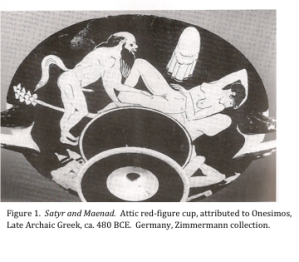In ancient Greece, “In order to achieve adult female status a woman has to become an object as much as a subject; she has to accept and embrace her objectification by the dominant discourses of her culture and internalize a construction of her identity.”[1]
Maenads have often been discarded as flippant characters within Greek mythology, bearing little significance in iconography of ancient Greek vase painting. Few have focused on their importance as individual characters within the narrative of the Dionysian cult. Furthermore, the role of voyeurism in both the depiction and consumption of maenadic figures has long gone unchecked. In order to fully understand the female citizen in ancient Greece, it is crucial to ask the question: In what ways are maenads depicted as agents and active figures and/or non-agents and passive figures? Why and how are these figures objectified? As Barbara Goff states, in the context of ancient Greece a woman must come to terms with her situation as ‘object’ within her own culture. What follows is a close examination of the mythical depictions of maenads and how they proved to represent larger social constructions of women and their relationship to men by embodying both socially normalized ideals of femininity and an oppositional inversion of such stereotypes. Continue…


